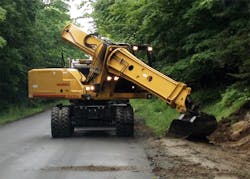Low-profile reach under trees ideal for Maine ditch cleanout work
Maintaining highways and the drainage ditches alongside them is a major task for the Maine Department of Transportation (MaineDOT). Some 83% of all land in Maine is forested along hilly roads, meaning there is plenty of opportunity for large amounts of silt runoff to regularly fill drainage ditches. That challenge creates flooding problems, which translates into potentially icy highways in the winter.
A Gradall XL 4300 III excavator with a grading bucket is the ideal tool to clean ditches along Rte. 11, just off Rte. 15 northwest of Bangor, where silt runoff regularly flows down the steep hills on both sides of the road, with soft shoulders or none at all to provide a solid foundation for digging equipment.
The primary advantage of applying Gradall excavators to the ditch cleanout operation is their ability to reach out and underneath large tree limbs that hang over the roads and ditches. The telescoping boom extends under the trees and sometimes even through the branches, an ability that poses a problem for conventional knuckle boom excavators.
The entire Gradall boom tilts 110° in either direction, properly positioning cleanout attachments to remove material from different angles without causing problems positioning the machine. And because the entire boom tilts, there’s no loss of boom power, which is a drawback for boom-end devices that attempt to rotate attachments on knuckle booms.
With front axle lockout cylinders, a stable wheeled undercarriage and the low-profile boom design, Gradall excavators can maneuver with full bucket loads of material, speeding up the cleanout process. Operators can also extend the boom out to either side of the undercarriage, or to the front or back, without the need to lower optional outriggers.
“The MaineDOT operator especially liked the maneuverability of the Gradall excavator,” said Steve Sawyer, product support sales representative for C.N. Wood, which provided a machine demo for the Bangor area MaineDOT office. “They can get up and down the road easily, and when they extend the boom, they don’t hook onto tree limbs.”
